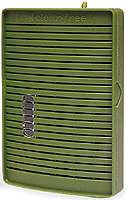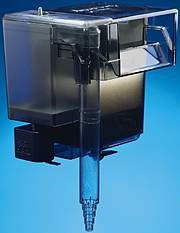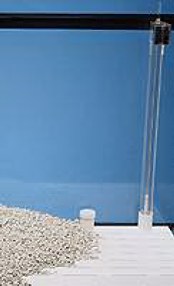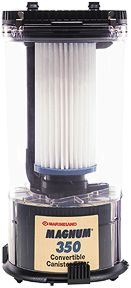| Filters: |
| Corner Filters |
| Backpack Filters |
| Under gravel Filters |
| Exterior Canister Filters |
| CORNER FILTERS: | |
| Even though this is submerged in the tank, it acts like the first type of filtration I briefly discussed. It is normally powered by an outside air source. Air is introduced through the bottom of the filter drawing water with it through the filter by creating a vacuum. The water passes over cloth and charcoal then returns to the tank through an outlet normally located towards the top. These filters do not have a lot of flow through them so they are ideal for really small tanks, especially tanks with fry ( babies ) in them. These type filters are very inexpensive and require biweekly changes at least. Additional costs are incurred with an air pump, hose, activated charcoal and baton material. |  |
 |
This is the second and probably most commonly found filter in aquariums under 60 gallons in size. The backpack filter is powered by an electric pump drawing water up and out of the tank via a slotted tube. The water goes into a large well and passes through a cartridge of cottony material and charcoal, sometimes a sponge as well. Then the water drops over the spill gate and returns to the top of the tank. The flow rate on some models can be changed for lighter duty during feeding times and when you have very small fish that may get sucked up into the filter. Very neat and tidy filters, for biweekly maintenance, simply remove one filter and replace with another. This is more costly but less hassle than any other filter system. Some of these types of filters have "Bio-Wheels", these are rotating drums of pocketed material. The pockets allow for a bacterial growth that aids in killing off the bad waste in the water. This is very low maintenance, and I encourage their use. Additional costs are cartridges, and the occasional impeller or tube when they break. |
| UNDER GRAVEL FILTERS (UGF'S) | |
| This Under Gravel Filter ( or UGF, as they are referred to ) is the most common filter found in toady's aquariums. The UGF is the second type of filtration that we discussed earlier in the page. As you can see in the photo, there is a slotted white plate, a covering of gravel or "substrate" and lift tubes towards the rear. These lift tubes either have an air stone and line inserted into them, the rising bubbles cause the water to circulate. Or the tubes have what is known as a "power head" attached to it. A power head is an electrical submerged pump the provides high water flows for larger tanks. This type filter is probably the easiest for the experienced hobbyist to maintain and the most difficult for the beginner. It requires patience when first starting out, something most beginning hobbyists usually do not have. The UGF draws the water down from the tank, through the gravel where the fish waste material gets trapped and broken down by enzymes. The water flows under the gravel in a cavity that the plates have provided, up the tubes and out into the tank. If a power head is used a great current is introduced into the tank, which direction and rate of flow can usually be directed. Additional costs are gravel, air pump or power head ( most likely a combination of both ) lift tube filter caps ( this is the black area you see at the top of the tube ) in charcoal or another material depending on what the water conditions requires. Click here for actual set up instructions |
 |
 |
The canister type of filtration is the least visible and most expensive type of filtration for the general hobbyist. Some canisters also allow the hobbyist to decide what type of filter medium as well as just how much of it he/she wants to use. Other canisters have pre-manufactured filters and medium packs that you can purchase individually or in larger more economical packs. I really like the simplicity behind the canister filters, I also appreciate the fact that they are the least intrusive to the aquarium. The down side to canister filters is the cost. Canister filters usually run 3 to 10 times the cost of most other types of filters. The canister filter is very basic, a freestanding unit on your floor plugged into the wall. Two tubes, one an intake the other a return, flow between the tank and the filter. A simple electric motor keeps the whole thing going. Additional costs can be filter packs, medium, tubing and the occasional impeller. |